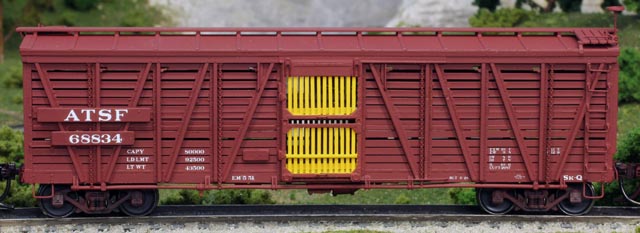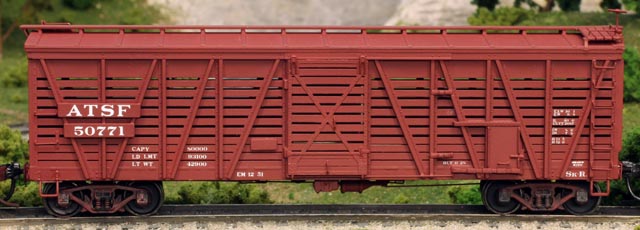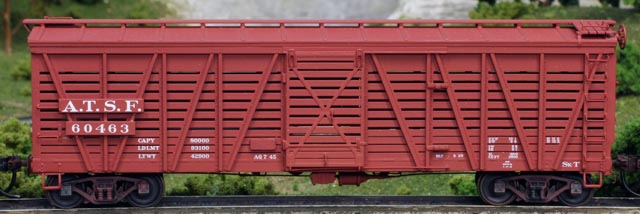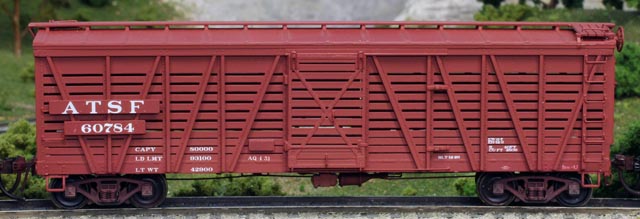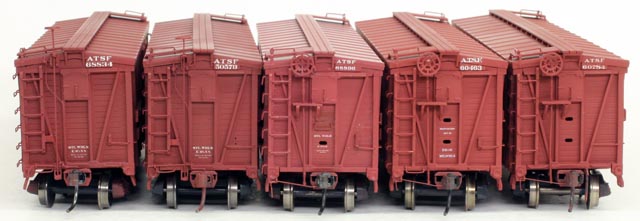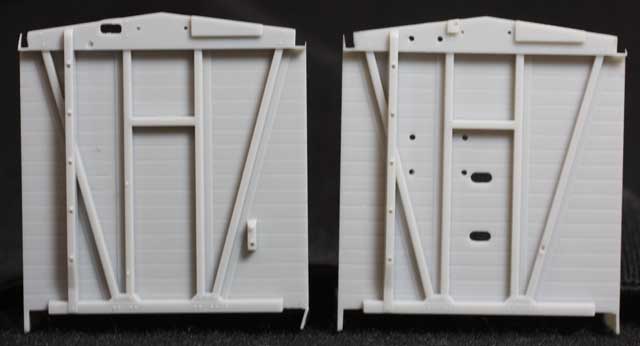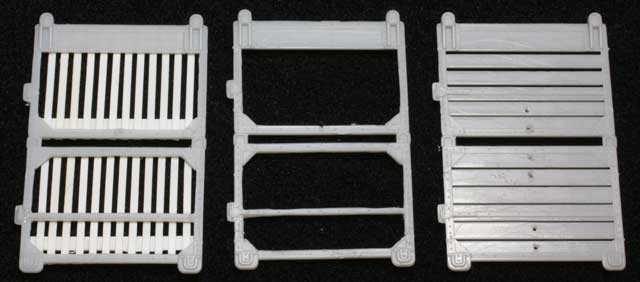Livestock Operations on Model Railroadswith an emphasis on the ATSFRevised February 2, 2013 |
||||||||||||||||||||||||||||||
| Intermountain
Prototype
All cars were built by the Pennsylvania Car Company. A full live list can be seen here. A live list by percentage of fleet is also posted. The double deck cars were convertible to single deck cars by means of a winching mechanism on the side of the car which would lift the upper deck up to the inside of the roof to get it out of the way if the car was to be used to carry horses or cattle. The Model Intermountain Railway Company has released flat side models of the SK-Q - SK-U stock cars beginning in 2004. Because they are similar, most of the same tooling can be used for all of these cars. Double deck side tooling was not produced (different board spacing at the roof line and safety latches), so the double deck cars are a compromise. The side that was produced does not match any of the single deck cars either in terms of board spacing, but the differences are small. The flat sides allow for relief on the inside of the slats. Both K and AB brakes are available. All grabs and piping is done in wire. Intermountain notes, "We are offering these as "stand in" models for the CB&Q and MoPac, both of them had cars that had the same basic "look."' Intermountain has produced two undec kits:
The kits come with the sub floor, chain lift mechanism, and double door parts included for modeling the convertible cars. Microscale decals 87-1254 will letter the cars. The ready to run cars are based on one of these two kits. Intermountain has produced cars lettered as SK-R, S, T, and U, but only the AB brake SK-U and K brake SK-R are 90% correct in RTR form. Basic time frames for ATSF paint are:
If you want cars with a Santa Fe prototype and are happy with the 2' viewing, you can stop reading here and go buy a bunch. If you are a rivet counter, continued to read. Critical Detail As built, SK-Q and R stock cars were equipped with K brakes and vertical staff brakes. SK-S, T and U had K brakes and Ajax equipment. In the 1940s many cars with K brakes were converted to AB brakes. After July 1, 1953, cars with K brakes could no longer be interchanged with other railroads. When the SK-Qs and Rs were upgraded to AB brakes, many (most, all?) retained their vertical staff brake wheels The author has not seen a photo of an SK-Q or R without a vertical staff brake wheel. Modelers will have to do some kitbashing to have AB brakes and vertical staff since Intermountain does not offer this option out of the box in either kit or RTR form. Intermountain will sell individual sprues from their kits but the ends of the AB and K brake kits are different.
Intermountain's first runs had funky drop grab irons (see above SK-S). Later production has more to scale grabs. First runs of the SK-S convertible car did not have the lift mechanism and chains installed. These are on more recent runs. Modelers can contact Intermountain to obtain these at no charge and install and paint them themselves. Floquil Mineral Brown is a good match. The ends on the different prototype classes were all different.
The end ladders should really be free-standing, with angle-stock stiles mounted on standoffs. To do that you need to scrape off the stile molded onto the car end and redo the ladders. The SK-R and Q had end ladders that stopped below the bottom rung and large angle supports for the ladder. The SK-S, T, and U had ladders that continued to the end sill.. Intermountain chose not to include the bottom grabs on any of the cars. For the SK-Q-T these included a drop grab on the left (to avoid conflict with top operating uncoupler lever) and straight grab on the right of the rear base. The SK-U had straight grabs on both sides and bottom operating uncoupler. Nor did IRC include the uncoupling linkage. These originally were on top of the coupler, but were later moved to the bottom on some but not all. The hanger for the bottom operating uncoupler lever is molded to the end and can easily be drillout out and uses. The cars were built with wooden drover doors in the end. Steel doors replaced these as needed. Some think the SK-U were produced with steel drover doors. Many cars went to scrap with the wooden doors. Both are included in the kits, but the steel doors appear on the AB brake RTR models. As produced, the cars came with a single grab on the left end of the side. The upper or second grab was added in the 1940s. All RTR cars come with the second grab. Modelers of an earlier time will want to cut off the mountings for the upper grabs. The SK-Q had no side door stops. The modeler will want to fill those molded locations. The SK-R had then on boards 4 and 9 from the sill, SK-S on boards 5 and 9, and the SK-T & U on boards 2 and 9 (as in the kit). The double doors that come with the kits and SK-S are correct. However, the SK-Q had vertical slat doors which IMC has not produced. See the kitbashed door on the SK-Q photo above. The prototype had 12 slats. In the photo below, .010 x .030 Evergreen styrene was used for the vertical slats. This will not make a totally correct door as there are hardware differences, but it will be visually much more acceptable. The lower door runners are different on the SK-R and S from each other and from the single deck cars.
As mentioned above the sides on the model represent the single deck cars. The double deck cars did not have the uppermost boards butted against each other as on the model. They had seperate boards like the rest of the side plus 6 "dogs" on each side which were used to hold the moveable deck in the upper position. Working with a kit, the modeler can remove those upper boards and apply evergreen strips appropriately. The photo above of the SK-Q shows this change. Compare it with the stock SK-S to see the difference. The Kadee coupler pocket is black on the RTR models and needs to be painted Mineral Brown. The cars come with smaller scale Kadee #58 couplers. Some owners have reported the coupler being slightly high requiring the coupler pocket to be shimmed down from the car .10 - .30". Others feel the car is a little high and needs to be lowered. Some of this can be blamed on inconsistent assembly. Sometimes the bolster does not sit level end to end and requires some attention. If the cars derail, this is the first place to look. Ten of the SK-Rs received a steel door for small animals
toward the brake end and was partitioned internally for mixed animal shipping. This door was located at the floor midway between the
regular door and the end of the car, on one end only. Pecos River Brass and Sunshine Models offer
this car. It is an easy addition to the model (see SK-R photo above). The door does require some creative placement of lettering. Those cars should also have 3 (possibly 4) partition anchor eyes located in the space between the topmost boards, another detail left off of the model shown above. Ted Culotta reports that "the Accurail "Bettendorf" is the best available truck for the IM ATSF stock cars." This was before Tahoe came out with their excellent trucks. The authoritative book on Santa Fe stock cars is the out of print, Stock Cars of the Santa Fe Railway by Frank M. Ellington, John Berry, and Loren Martens. In 2012 it is being revised and rewritten by the society. Helpful photos can also be found in the Stock Car Cyclopedia, Vol. 1, by Robert L. Hundman. These cars were also produced in brass by Pecos River and in resin by Sunshine. Preserved cars include (info on others is invited):
Review by Steve Sandifer |
||||||||||||||||||||||||||||||








